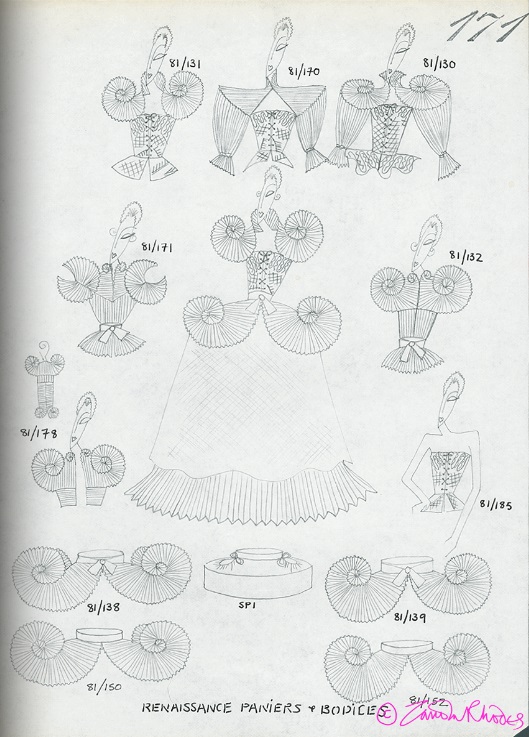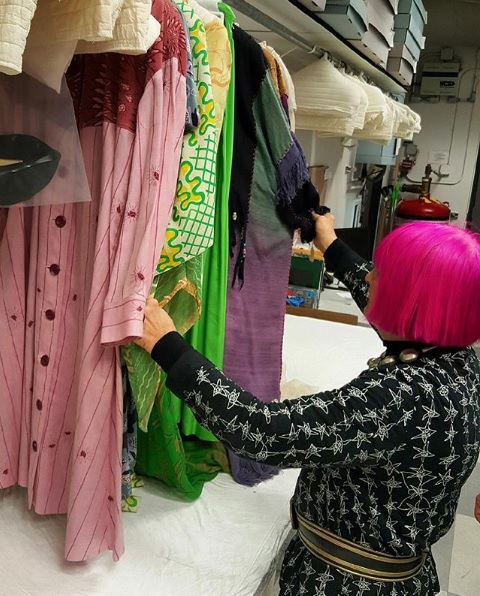Zandra Rhodes: Renaissance Gold
Turning the corner into our Acquiring Beauty exhibition, we often hear the ‘oohs and ahhs’ of visitors greeted with an impressive sight: a magnificent Zandra Rhodes pleated gold lamé ensemble fit for a queen. The majestic gown does indeed have a British royal background – a fitting provenance for the charming pink-haired designer who cites her home country as the inspiration behind many of her collections.[1]
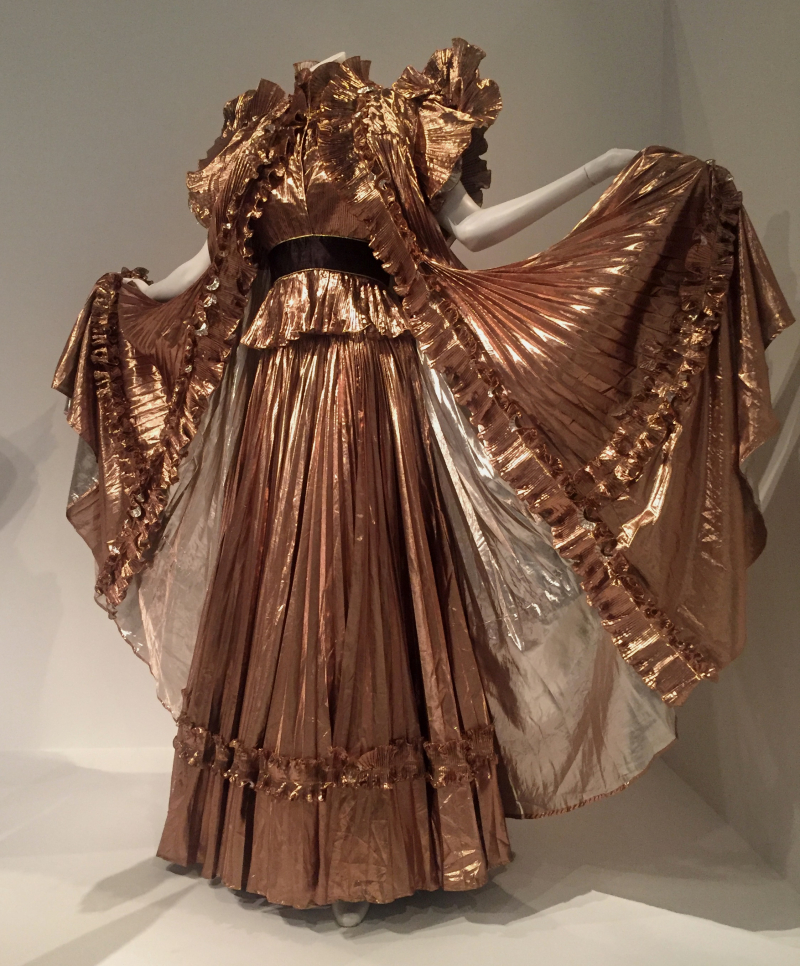 Evening Ensemble
Evening Ensemble
Zandra Rhodes
London, England, Fall 1981
FIDM Museum Purchase: Funds raised by the FIDM Museum Fashion Council, 2015
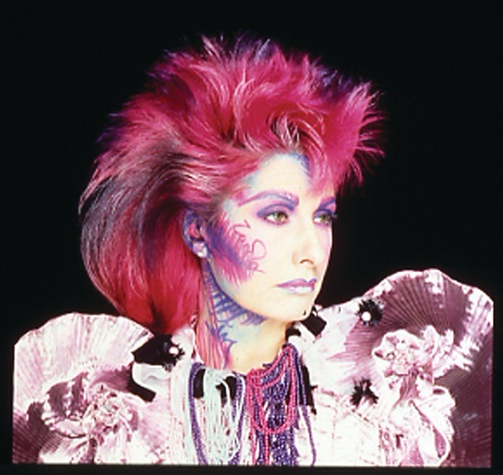
Pink Mane Portrait 1985: photograph by Robyn Beeche, makeup by Yvonne Gold.
Rhodes wears a piece from the Renaissance Gold Collection. Before she created her lamé homage to the Elizabethan era, Rhodes built her career on her groundbreaking textile designs, which she used to create unconventional fashion silhouettes. Born in Kent in 1940, she began sketching the picturesque countryside around her at a young age, and continued this habit throughout her career – turning chance encounters illustrated in her notebook into entire collections. She later remarked that her designs evolved “through an interpretation of my surroundings, seen in my own special way.”[2] Her mother was once a fitter at Worth in Paris and later a fashion lecturer at Medway College of Art; Rhodes names her as the biggest influence on the direction of her life, crediting her with introducing a love of design, the courage to stand out, and an unrelenting work ethic.[3] When she embarked on her studies at Medway College of Art (now part of the University for the Creative Arts), Rhodes focused on printed textiles rather than fashion, and later continued this education at the Royal College of Art, graduating in 1964. Her textile career failed to take off immediately; she worked freelance selling her print designs, and taught two days a week at The Ravensbourne School.[4] There she met fashion designer Sylvia Ayton, and the two formed a partnership. They opened the Fulham Road Clothes Shop in 1968 – a time when London’s swinging fashion scene was awash with youthful clothing shops such as Granny Takes a Trip, Mr. Fish, and the Apple Boutique.
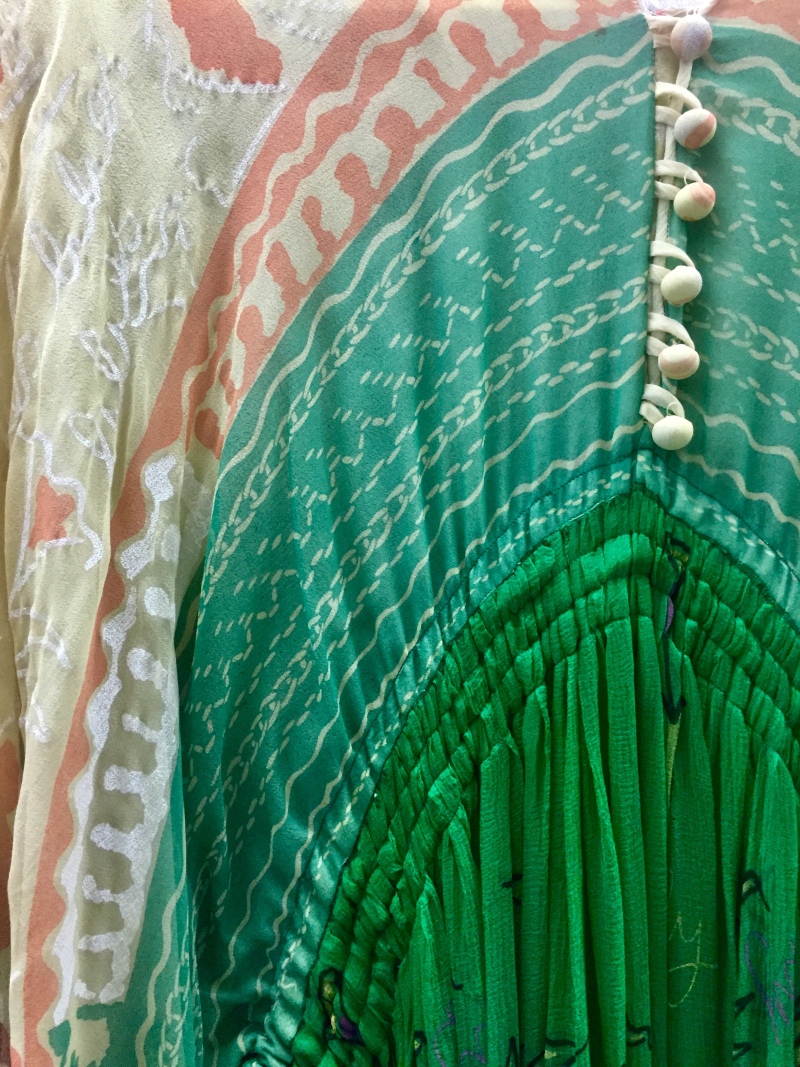 Detail of Zandra Rhodes chiffon gown, FIDM Museum, c. 1980.
Detail of Zandra Rhodes chiffon gown, FIDM Museum, c. 1980.
Rhodes finally found her niche when she decided to combine her textile expertise with innovative fashion designs. A self-taught fashion designer, she relied on draping and pinning to discover new silhouettes. Ultimately, she let the fabric direct her work: “In learning to design for dress fabrics, I was involved in a special adventure, that of patterns which would not hang flat but would be cut and put together again in many different ways.”[5] Her bohemian aesthetic and brightly printed flowing chiffon gowns became her trademark. She soon outgrew the boutique, and established her own fashion line in 1969. Her first collection, called the Knitted Circle, was a series of chiffon dresses printed with a design based on a chain stitch, a reference to her mother’s knitting books that Rhodes read as a child.[6] Fortnum & Mason picked up the collection in London, and thanks to a letter of introduction from Diana Vreeland, she found further success in New York – the collection was quickly bought by Henri Bendel.[7]
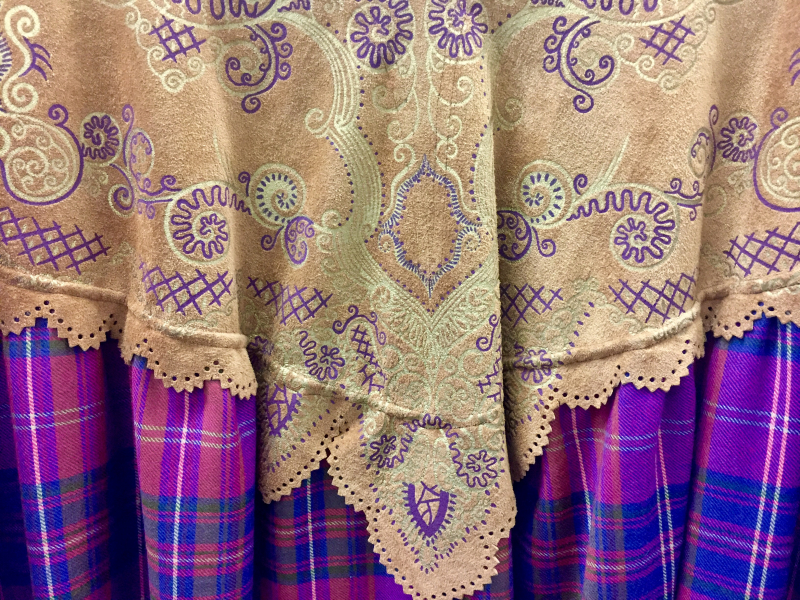 Detail of Zandra Rhodes faux suede and flannel dress, FIDM Museum, c. 1975.
Detail of Zandra Rhodes faux suede and flannel dress, FIDM Museum, c. 1975.
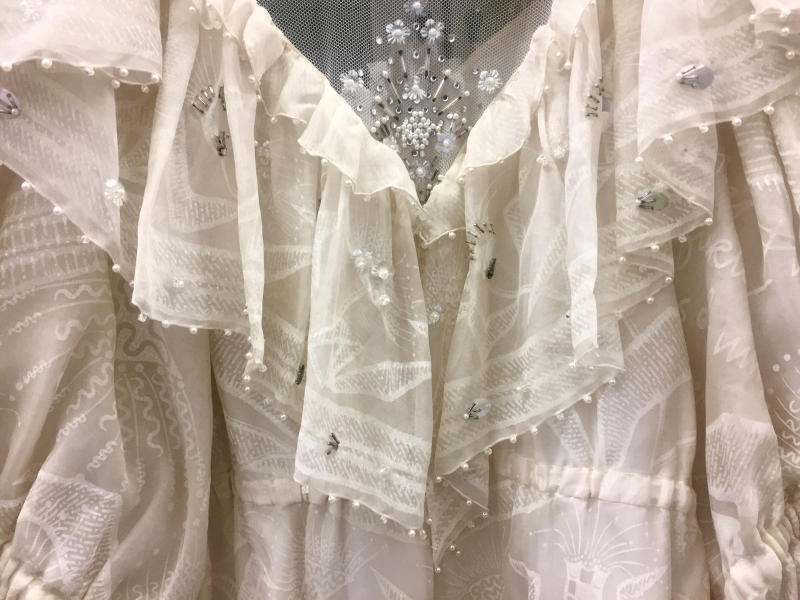 Detail of Zandra Rhodes chiffon gown, FIDM Museum, c. 1972.
Detail of Zandra Rhodes chiffon gown, FIDM Museum, c. 1972.
A rising fashion star in the 1970s, Rhodes’s explored her fascination with several design ideas throughout the decade - first and foremost the inspiration derived from her extensive travels. Australia, Africa, Mexico, ancient Egypt, India, China, the Old West, and more ethnic influences made their way into her textiles.[8] She also freely embraced glam rock, experimenting with torn fabrics, chains, and safety pins while dressing Queen front man Freddy Mercury.[9] But it was a much-anticipated royal wedding that was the impetus behind the regal gown now residing in our gallery: the July 1981 union of Prince Charles and Lady Diana Spencer.
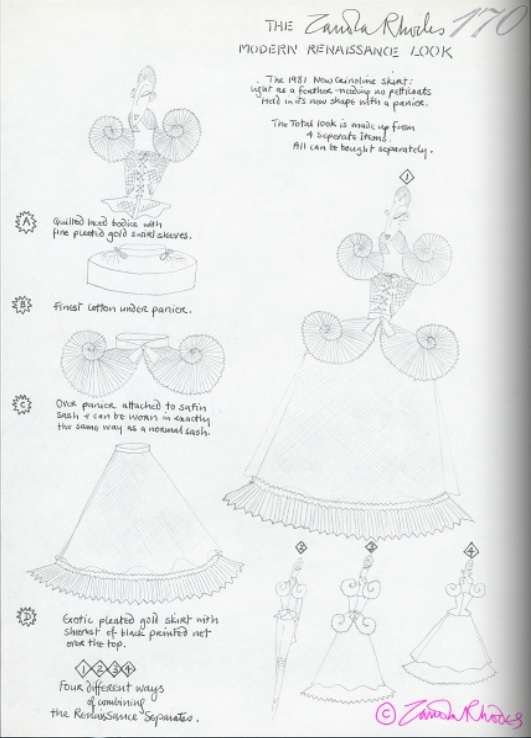
Zandra Rhodes Style Bible 5 (1981 - 1982), Zandra Rhodes Digital Study Collection.
The marriage between Charles and his fairytale bride brought a renewed sense of romance, elegance, and extravagance to London’s fashion scene. Rhodes recalls, “English Vogue rang me up and they said ‘We’re doing a collection – we’re going to dress a very famous person!’”[10] The magazine asked notable British designers to sketch their ideas for Diana’s wedding gown. Rhodes reflects, “Well what else would I put an Elizabethan bride in but gold lamé and panniers and all the pleating?”[11] Rhodes had begun experimenting with lamé and pleats in the late 1970s, most notably with a dress worn by model Pat Cleveland to Studio 54 in 1977. Yet her Autumn/Winter 1981 collection introduced a new element of grandeur and historicism, combining her study of Elizabethan dress and panniers from the Victoria & Albert Museum with the synthetic modern material.[12] Rhodes even accessorized the ensembles with jeweled crowns to add to their sartorial splendor.[13] The unapologetically glamorous display was fitting for the arrival of 1980s glitz and excess. The Renaissance/Gold Collection consisted of separates that could be worn together or individually, creating an “instant fantasy”[14] for the wearer. Though ultimately not worn by the Princess, another Diana – Ross – donned the Renaissance look for a Vogue editorial shot by the legendary Richard Avedon.
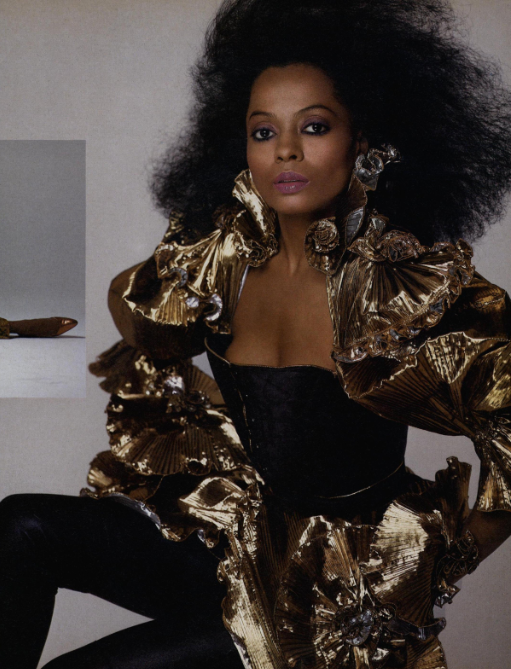
Diana Ross photographed by Richard Avedon, Vogue, December 1981.
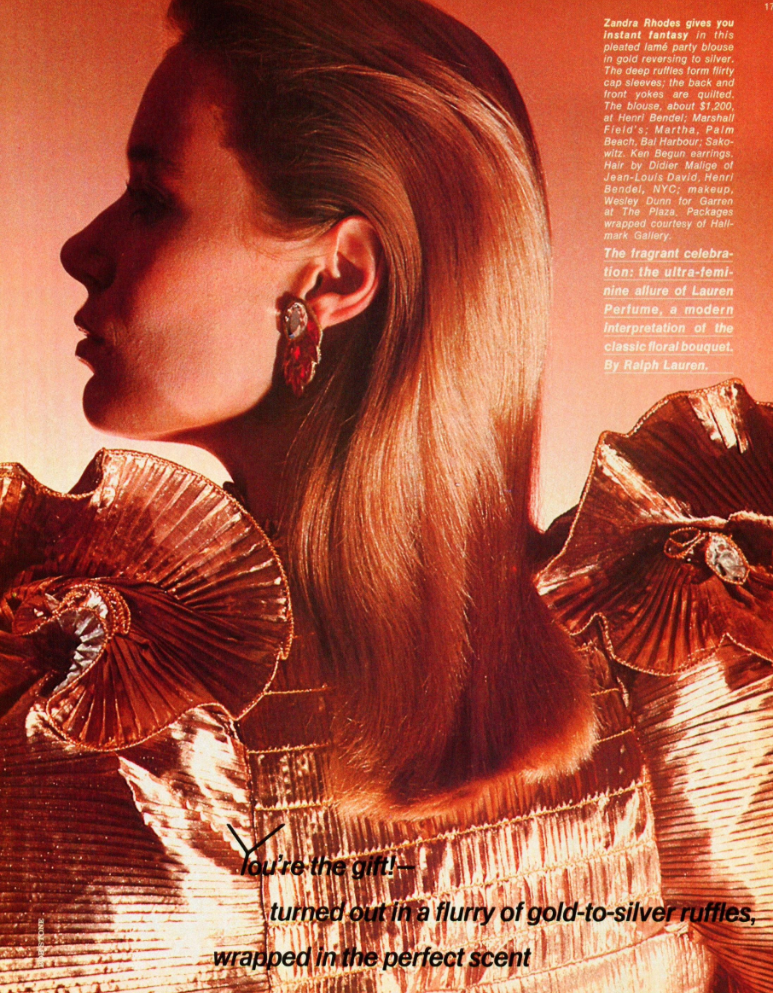 Renaissance ensemble photographed by Bob Stone for Harper's Bazaar, December 1981.
Renaissance ensemble photographed by Bob Stone for Harper's Bazaar, December 1981.
The Renaissance Collection was not the first or last time Rhodes turned to historic dress for inspiration. She often visited museum collections to ignite her muse; her Slashed, Cut Silk and Smocking Collection (1971) was comprised of textile designs based on a slashed bodice at the V&A. She also looked to her British roots, and English fairy tales in particular, for collection ideas, such as Cicely Mary Barker’s Flower Fairy Books (The Fairy Collection, 1982; Fantastic Flower Garden, 1986) and Lewis Carroll’s Alice in Wonderland for (Queen of Hearts, 1989).[15]
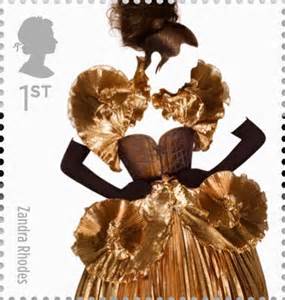
Special Edition Royal Mail Stamp released in 2012; Renaissance ensemble photographed by Sølve Sundsbø.
Rhodes’s devotion to British culture continues today. In 2003, she opened the Fashion and Textile Museum in South London – a project she undertook completely from start to finish, even selling her Notting Hill home to pay for the warehouse that eventually became the museum grounds.[16] The distinctive bright orange and pink building designed by Mexican architect Ricardo Legorreta houses Rhodes’s personal archive, but its exhibitions showcase a range of designers and themes. Now operated by Newham College, the Museum is a place of education and learning for future designers. Rhodes also partnered with the University of Creative Arts (where she was named a Chancellor in 2010) to establish a Digital Study Collection, providing a free online resource of sketches, video interviews, and collection photographs for researchers and students. Her contributions to the United Kingdom were recognized when she was made a Commander of the British Empire in 1997, and later a Dame Commander in 2014.[17]
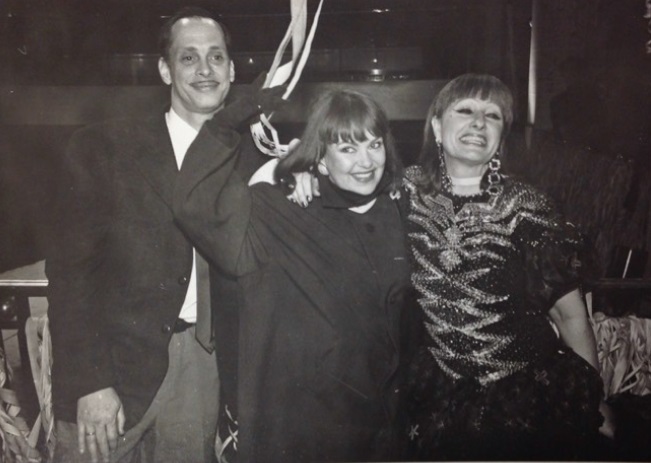 Postcard snapshot of Zandra Rhodes (far right) with John Waters (far left) and Pat Moran (middle) at Henri Bendel promotional party, c. 1991-1993 Gift of Joan Beer Damask & Donald Damask, SC2013.1250.33
Postcard snapshot of Zandra Rhodes (far right) with John Waters (far left) and Pat Moran (middle) at Henri Bendel promotional party, c. 1991-1993 Gift of Joan Beer Damask & Donald Damask, SC2013.1250.33
If you live in Southern California, perhaps you’ve seen the unmistakable designer out and about – she now splits her time between London and San Diego, where she lives with her partner Salah Hassanein. She has even dabbled in costume design for the San Diego Opera, creating imaginative worlds for its productions of The Magic Flute and The Pearl Fishers.[18] On a trip to Los Angeles in 2016, Curator Kevin Jones was lucky enough to show Dame Zandra Rhodes her work in the FIDM Museum Collection - including the Renaissance Gold ensemble. The iconic gold collection, and her entire avant-garde body of work, is a testament to Rhodes's design philosophy: "I can't and won't design for people who hide in a corner. Fashion should be about becoming a peacock."[19]
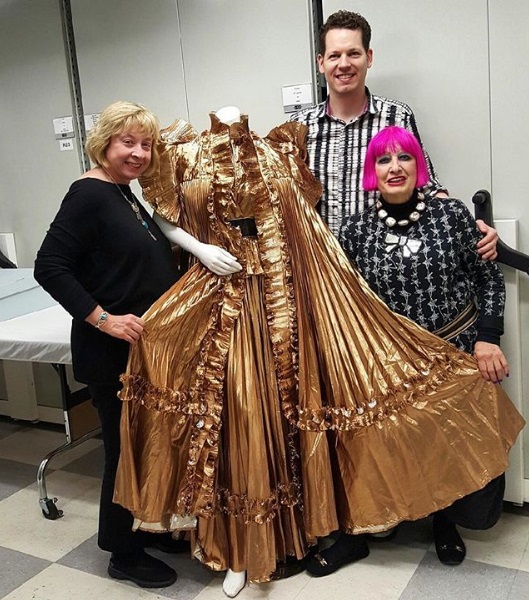
Dame Zandra Rhodes visits the FIDM Museum with Curator Kevin Jones and Fashion Council Member Deborah Veady in 2016.
[1] Amy de la Haye, The Cutting Edge: 50 Years of British Fashion, 1947-1997 (London: Overlook Books, 1997), 196. [2] Zandra Rhodes and Anne Knight, The Art of Zandra Rhodes (London: Michael O’Mara Books, Ltd., 1994), 9. [3] Ibid., 11 [4] Brenda Polan, ‘The Art of Textiles,’ Zandra Rhodes: A Lifelong Love Affair with Textiles (London: Antique Collectors’ Club Ltd. and Zandra Rhodes Publications Limited, 2005), 15. [5] Rhodes and Knight, The Art of Zandra Rhodes, 12. [6] The Zandra Rhodes Digital Study Collection, ‘Ask Zandra,’ Zandra’s First Collection: http://www.zandrarhodes.ucreative.ac.uk/2013/02/zandras-first-collection.html [7] Ibid. [8] Polan, Zandra Rhodes: A Lifelong Love Affair with Textiles, 16. [9] Christopher Breward, Edwina Ehrman, and Caroline Evans, The London Look: Fashion from Street to Catwalk (New Haven: Yale University Press, 2004), 137. [10] The Zandra Rhodes Digital Study Collection, ‘Ask Zandra,’ The Renaissance/Gold Collection: http://www.zandrarhodes.ucreative.ac.uk/2013/02/the-influence-behind-renaissancegold.html [11] Ibid. [12] Renaissance Cloth of Gold Crinoline, Victoria & Albert Museum: http://collections.vam.ac.uk/item/O15681/renaissance-cloth-of-gold-crinoline-ballgown-rhodes-zandra/ [13] Mary Lou Luther, ‘Renaissance of Regal Chic,’ Los Angeles Times, April 2, 1981. [14] ‘Irresistibles: The Tempting Treasures That Can Make Your Holidays – And You – Unforgettable, Harper’s Bazaar, December 1981. [15] de la Haye, The Cutting Edge, 198. [16] Lizette Alvarez, ‘A New Museum Crowns a Career’, The New York Times, May 27, 2003. [17] University for the Creative Arts, Creative Careers, Dame Zandra Rhodes RDI: https://www.uca.ac.uk/creative-careers/success-stories/dame-zandra-rhodes-rdi/ [18] Carolyn Benesh, ‘The Art of Significant Loveliness,’ Ornament, Vol. 34, Issue 3, 2011. [19] Andrew Tucker, The London Fashion Book (New York: Rizzoli, 1998), 152.
